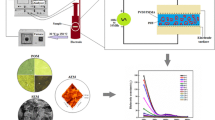Abstract
Organoplastics are multifunctional materials for a wide range of applications. However, their dielectric characteristics are rarely noted: organoplastics are dielectrics, which exhibit a high dielectric strength, specific volume resistance, and a low dielectric loss factor. The level of preservation of the electrophysical characteristics of organoplastics is as good as that of glass–fiber-reinforced plastics under the action of climatic factors; organoplastics exhibit high stability of characteristics after long-duration humidification.

Similar content being viewed by others
REFERENCES
G. F. Zhelezina, I. N. Gulyaev, and N. A. Solov’eva, “Aramide organic plastics of new generation for aviation designs,” Aviats. Mater. Tekhnol., No. S, 368–378 (2017).
A. S. Kolobkov, “Polymer composite materials for various aircraft structures (review),” Tr. VIAM, Nos. 6–7, 38–44 (2020).
V. V. Krivonos and Yu. M. Tarasov, “Innovative composite materials and technologies in aircraft construction,” in Composites in CIS: Digitalization and Value Analysis of the Product Life Cycle (Musthavevents, Moscow, 2018), pp. 23–26.
G. F. Zhelezina, N. A. Solovieva, K. V. Makrushin, and L. S. Rysin, “Polymer composite materials for manufacturing engine air particle separation of advanced helicopter engine,” Aviats. Mater. Tekhnol., No. 1, 58–63 (2018).
E. N. Kablov, N. Yu. Podzhivotov, and A. N. Lutsenko, “About need for creation of uniform information and analysis centerof aviation materials of the Russian Federation,” Probl. Mashinostr. Avtom., No. 3, 28–34 (2019).
E. N. Kablov, “New generation materials represent the basis for innovations, technological leadership and national security of Russia,” Intell. Tekhnol., No. 2, 16–21 (2016).
G. F. Zhelezina, S. I. Voinov, N. A. Solov’eva, and G. S. Kulagina, “Aramid textile laminate for shock-resistant elements of aviation constructions,” Russ. J. Appl. Chem. 92 (3), 404–409 (2019).
G. S. Kulagina, G. F. Zhelezina, I. V. Tikhonov, and M. S. Doriomedov, “Aramid organoplastics, status and prospects,” in Proc. of II Allrus. Sci.-Eng. Conf. “New generation polymer composite materials and manufacturing technologies” (All-Russian Institute of Aviation Materials, Moscow, 2017), pp. 79–91.
P. M. Shul’deshova, G. F. Zhelezina, N. A. Solov’eva, and E. M. Shul’deshov, “Aramide organoplastics for sound-proof designs,” Vopr. Materialoved., No. 4, 42–49 (2016).
M. M. Platonov, E. M. Shul’deshov, T. A. Nesterova, and V. A. Sagomonova, “Acoustic polymeric materials of new generation (review),” Tr. VIAM, No. 4, 9 (2016).
K. A. Shashkeev, E. M. Shul’deshov, O. V. Popkov, I. D. Kraev, and G. Yu. Yurkov, “Porous sound-absorbing materials (review),” Tr. VIAM, No. 6, 6 (2016).
E. M. Shul’deshov, I. D. Kraev, and M. M. Platonov, “Polymeric composition sound absorbing panel,” Tr. VIAM, No. 5, 7 (2017).
M. I. Valueva, “Modern materials and technologies used for body armor,” Vopr. Materialoved., No. 2, 197–207 (2017).
G. S. Kulagina, G. F. Zhelezina, and N. M. Levakova, “Antifriction organoplastics for high-loaded friction knots,” Tr. VIAM, No. 2, 89–96 (2019).
A. S. Agafonova and S. V. Kondrashov, “Features of a technology to manufacture monolithic glass-fiber plastics intended for radio engineering,” Aviats. Mater. Tekhnol., No. 1, 30–33 (2014).
I. D. Kraev, E. M. Shuldeshov, M. M. Platonov, and G. Yu. Yurkov, “Composite materials combining acoustic and radio shielding properties,” Aviats. Mater. Tekhnol., No. 4, 60–67 (2016).
N. E. Uvarova, D. V. Grashchenkov, N. V. Isaeva, L. A. Orlova, and P. D. Sarkisov, “High-temperature radio-transparent materials: Today and tomorrow,” Aviats. Mater. Tekhnol. No. 1, 16–21 (2010).
Yu. A. Mikhailin, Construction Polymeric Composite Materials, 2nd ed. (Nauchnye Osnovy i Tekhnologii, St. Petersburg, 2013) [in Russian].
V. V. Shirokov and A. M. Romanov, “Waveguide method research of honeycomb glass fibre plastics dielectric characteristics,” Aviats. Mater. Tekhnol., No. 4, 62–70 (2013).
A. A. Belyaev, A. M. Romanov, V. V. Shirokov, and E. M. Shul’deshov, “Measurement of honeycomb glass fiber plasticspermittivity in free space,” Tr. VIAM, No. 5, 6 (2014).
E. M. Shul’deshov, V. V. Lepeshkin, and A. M. Romanov, “Method of non-destructive testing of complex dielectric permittivity of input poorly filled layers of gradient radar-absorbing polymeric composite materials,” Tr. VIAM, No. 10, 11 (2014).
V. V. Murashov, “Determination of physico-mechanical characteristics and composition of polymer composites by acoustic methods,” Aviats. Mater. Tekhnol., No. S, 465 (2012).
V. V. Murashov, “Non-destructive testing of carbon-carbon composite material forgings and details for the reusable "Buran” spaceship,” Tr. VIAM, No. 4, 5 (2013).
Chul Kim Po and Gil Lee Dai, “Composite sandwich constructions for absorbing the electromagnetic waves,” Compos. Struct. 87, 161–167 (2009).
A. A. Belyaev, S. V. Kondrashov, V. V. Lepeshkin, and A. M. Romanov, “Radioabsorbing materials,” Aviats. Mater. Tekhnol., No. S, 348–352 (2012).
I. S. Deev, E. N. Kablov, L. P. Kobets, and L. V. Chursova, “The basic and applied research in the field of corrosion and ageing of materials in natural environments (review),” Tr. VIAM, No. 7, 6 (2014).
E. N. Kablov and O. V. Startsev, “The basic and applied research in the field of corrosion and ageing of materials in natural environments (review),” Aviats. Mater. Tekhnol., No. 4, 38–52 (2015).
K. V. Sorokin, V. V. Murashov, M. Yu. Fedotov, and V. A. Goncharov, “Prediction of fault propagation in polymer structures by determining the stiffness changes under the material actuation conditions,” Aviats. Mater. Tekhnol., No. 2, 20–22 (2011).
G. D. Roberts, D. M. Revilock, W. K. Binienda, W. Z. Nie, S. B. Mackenzie, and K. B. Todd, “Impact testing and analysis of composites for aircraft engine fan cases,” J. Aerosp. Eng., No. 15, 104–110 (2002).
V. V. Murashov, A. F. Rumyantsev, G. A. Ivanova, and N. G. Faizrakhmanov, “Diagnostics of the structure, composition, and properties of polymeric composite materials,” Aviats. Mater. Tekhnol., No. 1, 17–24 (2008).
Author information
Authors and Affiliations
Corresponding author
Additional information
Translated by N. Podymova
Rights and permissions
About this article
Cite this article
Shul’deshova, P.M., Zhelezina, G.F., Solov’eva, N.A. et al. Dielectric Characteristics of Structural Organoplastics. Polym. Sci. Ser. D 15, 96–100 (2022). https://doi.org/10.1134/S1995421222010178
Received:
Revised:
Accepted:
Published:
Issue Date:
DOI: https://doi.org/10.1134/S1995421222010178




